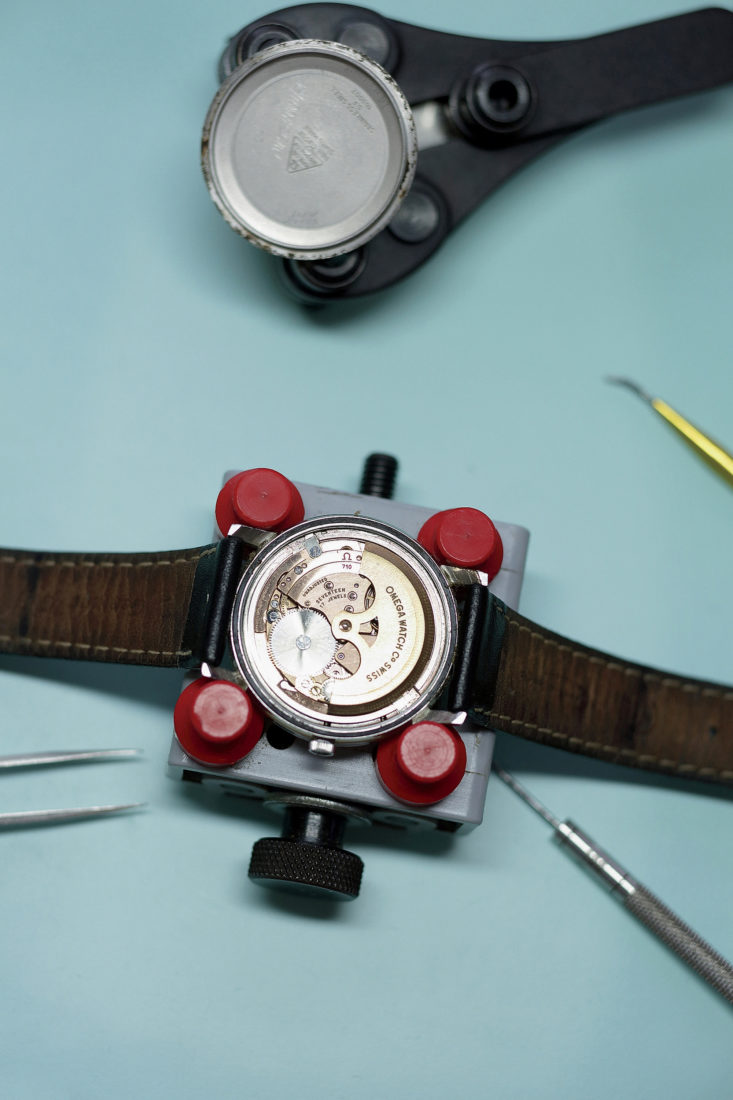Tennessee watchmaker Colin Britton takes a Swiss Army knife out of his pocket, extends a blade, and places the edge gently in a small opening in the back of my great-grandfather’s engraved gold Elgin pocket watch. Earlier, when I’d found the watch, along with a couple of old wristwatches, in my dad’s safe deposit box, I’d taken it home and tried to pry it open with my fingernail, without success. Now, tilting it toward the light streaming onto a consultation desk through the windows of his shop, Memphis Mean Time, Britton easily pops open the case and reveals, for probably the first time in three-quarters of a century, the intricate machinery of wheels and springs, now stilled.
He examines it with scholarly interest. “Looks like it just needs a COR—clean, oil, and regulate,” he says. He notes those service plans with a fountain pen on a small yellow envelope and slips the watch inside. With old watches like mine, he tells me, “so many people are like, ‘Oh, we were told this was unfixable.’ I say, ‘Dude, it just needs to be cleaned.’”
The sound track of the three rooms that compose Britton’s business—whose name recalls both the world’s timekeeping standard, Greenwich mean time, and the John Hiatt song “Memphis in the Meantime”—is the metronomic pulse of numerous clocks, which chime on the hour. A glass-fronted and -topped display case holds timepieces for sale, and beside it is the sun-splashed desk, where Britton proceeds to examine the two wristwatches I’ve brought in as well, an octagonal Elgin with a faulty stem and a 14-karat-gold art deco Milos that’s running slow.

Photo: Bob Bayne
Owner Colin Britton and apprentice Greg Faison inside the shop.
Bearded and bespectacled, with a past as an indie-band roadie and an MFA student in creative writing at the University of Memphis, Britton, now in his thirties, has found satisfaction in a very old trade that’s enjoying new popularity: watchmaking (the “making” covers repair as well as manufacture). Detroit’s Shinola has become a success story in that blighted city for producing vintage-inspired new watches, and websites and publications like WatchTime and Hodinkee .com have boomed by catering to a growing cohort of traditional timepiece fans.
Britton’s own interest in the field is rooted in literature, particularly Sherlock Holmes, a childhood favorite. “Because of the time it was set in, they all had pocket watches,” he says, so for him watches are “objects imbued with adventure.…I got one and I almost immediately broke it.” That mishap led to an encounter with longtime Memphis watchmaker Arthur Brown, who encouraged Britton to get into the trade. “There’s too much work,” Brown told him, “and not enough people.”
His career advice went unheeded until Britton found himself out in the dismal job market in 2008 after abandoning his MFA studies. He remembered Brown’s words and Googled “watch repair schools,” landing at Gem City College in Quincy, Illinois, for fifteen months, before moving back to Memphis and working for Las Savell Jewelry. Within a year, Britton had opened his own one-room shop and has since expanded to the second floor of a 1902 house in Memphis’s funky Cooper-Young district. He’s around the corner from Goner Records, a vinyl store and label, and across the street from Burke’s Books, in the city since 1875. “The whole old-world, old-school aesthetic of craftsmanship really fits with the neighborhood here,” he says.

Photo: Bob Bayne
Vintage timepieces with service notes await attention.
Before the move, he had taken on an apprentice, Greg Faison, a drummer who was looking for a flexible and steady career to pursue alongside the unpredictable life of a musician. Britton and Faison do most of their repair work in a large back room, seated behind individual workstations with multiarmed magnifying lenses attached to the temples of their eyeglasses. Banks of shallow-drawer cabinets containing the myriad minuscule parts required by their trade surround them. “Most anything we need,” Britton says, “we can pull from our stocks,” which he purchased from a retired Philadelphia watchmaker.
When I return a couple of weeks later to pick up my watches, Britton tells me that in addition to needing the COR, my great-grandfather’s old Elgin had a spring that was “tired” and needed replacing. “I’d wear that one,” he says of the Milos. “The lume still works!” Another customer, Emily Hazen, a Memphis architect and preservationist, comes in looking for a watch for her brother-in-law and homes in on a mid-century Russian model with Cyrillic numbers and a date register that goes only as high as the year 2000. “It expired with the Soviet Union,” Britton quips. Hazen’s excited with the unusual find since her brother-in-law is a fan of Cold War history. “We’re not going to go to a mall [to shop],” she says. “The story is part of it.”
I take my watches home, wind them firm, synchronize them by the website for the U.S. Naval Observatory clock, and place them on my dresser. When I check the next morning, they are still in sync, and I’m keeping time as my ancestors did. “If it’s a watch from your family,” Britton had said earlier, “more and more people think they’re a steward of it. It’s a legacy. It’s their job to maintain it for the next generation.”








